Virginia, often called the “Old Dominion,” is a state steeped in history, natural beauty, and cultural significance. Nestled between the Atlantic Ocean and the Appalachian Mountains, this state is part of the Mid-Atlantic and Southeastern regions of the United States.
With its rich tapestry of geography, from the picturesque coastline of the Atlantic Ocean to the rugged heights of the Blue Ridge Mountains, Virginia offers a diverse range of experiences to its residents and visitors. Its historic role in shaping the nation, vibrant urban centers, and stunning natural landscapes make Virginia a captivating destination.
Virginia is roughly 200 miles (322 kilometers) tall from its northernmost to southernmost point.
Facts to Know About Virginia
- Virginia is the birthplace of eight U.S. presidents, including George Washington, Thomas Jefferson, James Madison, James Monroe, William Henry Harrison, John Tyler, Zachary Taylor, and Woodrow Wilson. The state earned the nickname “Mother of Presidents.”
- The first Thanksgiving in America is believed to have occurred in Virginia in 1619, a year before the more famous Plymouth, MA event. English settlers at Berkeley Plantation along the James River held this early Thanksgiving celebration.
- Virginia is home to a significant portion of the Blue Ridge Parkway, a scenic highway famous for its breathtaking views, hiking trails, and opportunities for leaf-peeping during the fall foliage season.
- The Appalachian Trail, one of the world’s most famous long-distance hiking trails, passes through Virginia for over 500 miles.
- Virginia’s tourism slogan, “Virginia is for Lovers,” has been used since 1969 and has become an iconic part of the state’s identity.
Becoming Part of the United States
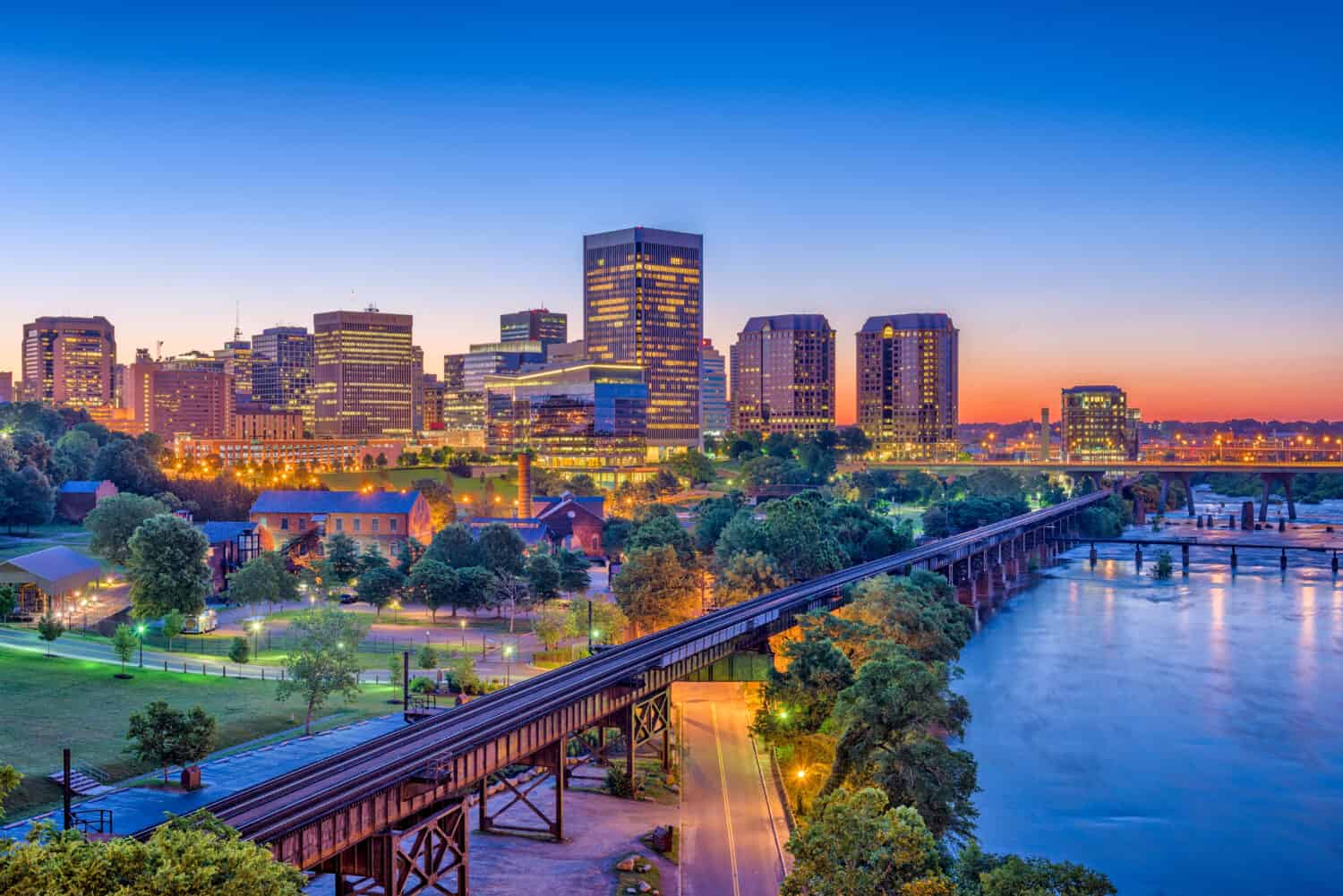
Richmond, Virginia’s capital, served as the capital of the Confederate States of America.
©Sean Pavone/Shutterstock.com
In 1607, English settlers, sponsored by the Virginia Company of London, established the first permanent English settlement in North America at Jamestown, VA. This event marked the beginning of English colonization in what would become the United States.
The Virginia Company of London hoped to profit from the colony’s resources, including tobacco, timber, and fish. However, they quickly suffered from financial troubles. King James I revoked the company’s charter in 1624, making Virginia a royal colony directly under the authority of the Crown.
Later, Virginia played a significant role in the lead-up to the American Revolution. The Virginia Resolves of 1765, adopted by the Virginia House of Burgesses, condemned the Stamp Act and asserted the colony’s rights. In 1775, the Second Continental Congress appointed George Washington, a Virginian, as Commander-in-Chief of the Continental Army.
American Revolution
A year later, Virginia was one of the 13 colonies that declared independence from British rule on July 4, 1776, by signing the Declaration of Independence. Thomas Jefferson, a Virginian, authored the document, which outlined the colonies’ grievances against the British Crown.
Virginia also played a vital role in the formation of the U.S. Constitution. James Madison’s Virginia plan outlined a robust national government with three branches: legislative, executive, and judicial. He drafted it at the Constitutional Convention in Philadelphia in 1787. Virginia delegates made significant contributions to the final document.
Virginia was one of the original 13 states that ratified the U.S. Constitution in 1788. It officially became the 10th state to join the Union on June 25, 1788. As a state, Virginia continued to have a prominent role in early American politics and played a crucial part in the nation’s westward expansion.
Virginia’s early history and contributions to the American Revolution and the founding of the United States make it a crucial part of the nation’s heritage.
Geography of Virginia
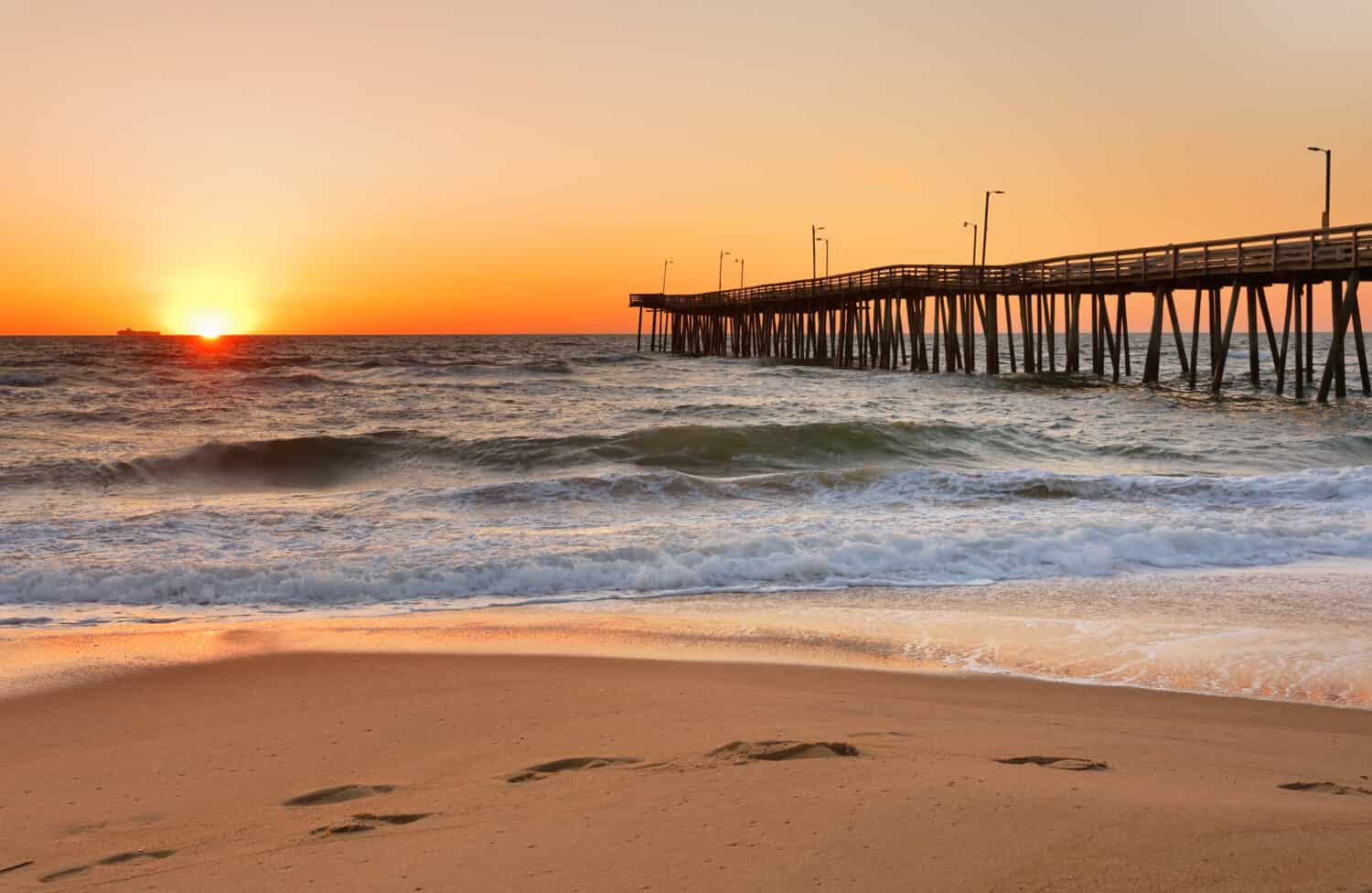
The Old Dominion State is the perfect mix of access to cities, beaches, and mountains.
©Jay Yuan/Shutterstock.com
Virginia is home to diverse landscapes, including coastal plains, mountains, valleys, and many natural features. This geographic diversity contributes to the state’s scenic beauty and role as an outdoor activity hub.
Virginia’s coastline along the Atlantic Ocean stretches for hundreds of miles in the eastern part of the state. The coastal plain, known as the Tidewater region, is characterized by flat, low-lying terrain, numerous rivers, and tidal estuaries. The Chesapeake Bay, one of the largest estuaries in the world, defines much of Virginia’s eastern geography. This area is crucial for its natural beauty and economic significance, as it supports commercial fishing, shipping, and tourism.
Moving westward, the geography transitions to the Piedmont region, a gently rolling plateau that extends into North Carolina. The Piedmont is characterized by fertile soil, making it suitable for agriculture. Historically, it was an important area for tobacco cultivation, and today, it remains an essential part of Virginia’s agricultural economy.
In the southwestern part of the state, the geography becomes more rugged with the Appalachian Plateau and the Allegheny Mountains. Rugged terrain, forests, and abundant wildlife characterize this region. It is a haven for outdoor enthusiasts, offering opportunities for hiking, camping, and exploring the region’s natural beauty.
Numerous rivers, including the James River, the Potomac River, and the Rappahannock River, shape the state’s geography. These have all played significant roles in transportation, trade, and industry.
Blue Ridge Mountains
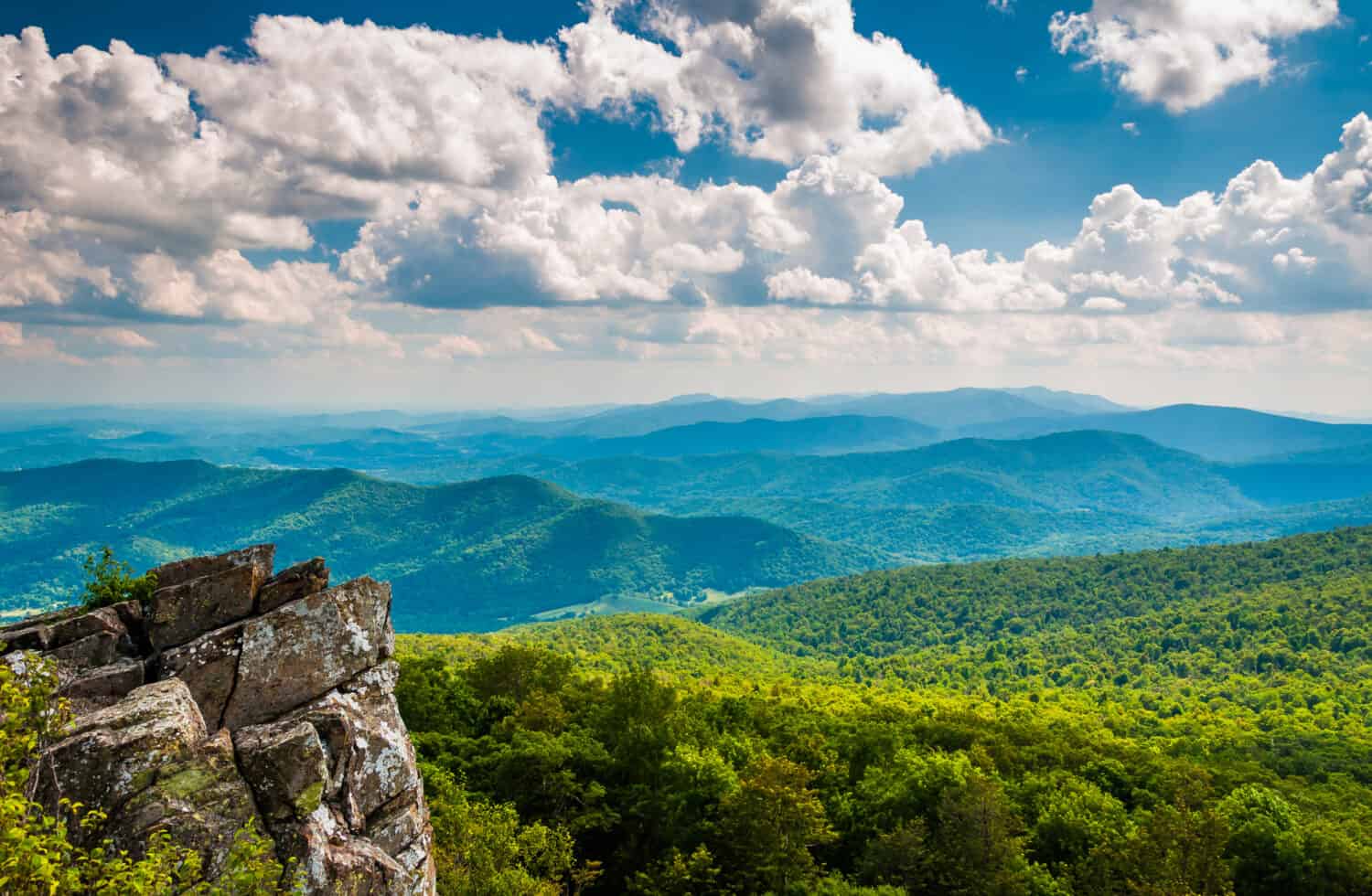
The Blue Ridge Mountains spread across Alabama, Georgia, Maryland, North Carolina, Pennsylvania, South Carolina, Tennessee, Virginia, and West Virginia.
©Jon Bilous/Shutterstock.com
Virginia’s most prominent geographic feature is the Blue Ridge Mountains, part of the larger Appalachian Mountain range. These mountains are famous for their stunning vistas, lush forests, and numerous hiking opportunities. Shenandoah National Park, located in this region, is home to the scenic Skyline Drive, a popular attraction offering panoramic views of the surrounding landscapes.
To the west of the Blue Ridge Mountains lies the Shenandoah Valley, a fertile and picturesque area flanked by mountain ranges on both sides. The valley is known for its agricultural productivity and is often called the “Breadbasket of the Confederacy” due to its importance during the American Civil War.
Virginia’s geography is incredibly diverse, encompassing coastal areas, fertile plains, mountain ranges, and picturesque valleys. This diversity contributes to the state’s natural beauty. It supports various economic activities and outdoor recreational opportunities, making Virginia a unique and dynamic part of the United States.
Overall Size of Virginia
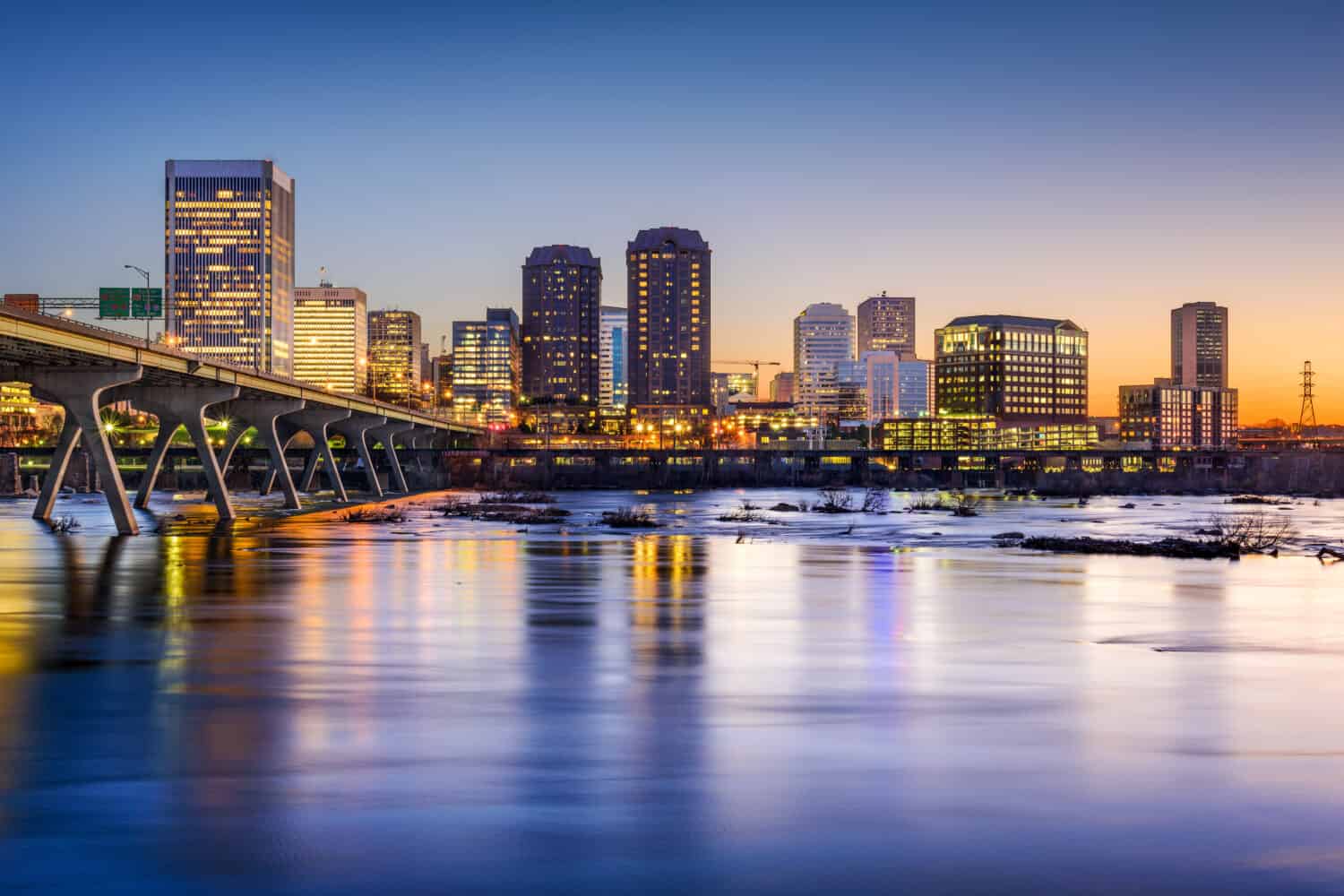
Despite its small size, Virginia has a large population.
©ESB Professional/Shutterstock.com
Virginia boasts a land area that covers approximately 42,775 square miles (110,787 square kilometers). In terms of size, it ranks as the 35th largest state in the United States. Its dimensions extend approximately 200 miles (322 kilometers) from its northernmost point to its southernmost point, and its width spans roughly 430 miles (692 kilometers) from east to west at its widest point.
With its moderate land area, Virginia represents about 2.2% of the total landmass of the United States. This percentage may seem small compared to the country’s vast size. Still, Virginia’s geographic diversity, ranging from the coastal plains to the Blue Ridge Mountains, makes it a microcosm of various American landscapes.
As of the 2023 estimate, Virginia has a population of approximately 8,820,504 million people, making it the 12th most populous state in the U.S. Its population density varies significantly across regions, with the Northern Virginia metropolitan area, including cities like Arlington and Fairfax, being one of the most densely populated areas in the state.
Virginia’s population has been growing steadily, driven partly by economic opportunities, government employment (due to its proximity to the nation’s capital, Washington, D.C.), and diverse industries. The state’s history, cultural attractions, educational institutions, and natural beauty also contribute to its appeal as a place to live and work.
Where Is Virginia Located on the Map?
Virginia is a state in the Mid-Atlantic and Southeastern regions of the United States. The Old Dominion State is between the Atlantic Coast and the Appalachian Mountains.
It borders several states, including Maryland to the north, West Virginia and Kentucky to the west, North Carolina to the south, and Tennessee to the southwest. But it Virgnia is most famous for its proximity to Washington, D.C, which makes it a key area for government-related employment and activity.
Virginia Height in Comparison to Other States
Let’s compare Virginia’s length from north to south to some other states.
| State | North-to-South Length (Approximate) |
|---|---|
| Alaska | 1,420 miles (2,285 kilometers) |
| Texas | 801 miles (1,289 kilometers) |
| California | 770 miles (1,239 kilometers) |
| Florida | 447 miles (719 kilometers) |
| Maine | 320 miles (515 kilometers) |
| Oregon | 295 miles (475 kilometers) |
| New York | 285 miles (455 kilometers) |
| Virginia | 200 miles (322 kilometers) |
| Kentucky | 187 miles (302 kilometers) |
| North Carolina | 184 miles (296 kilometers) |
Wildlife In Virginia
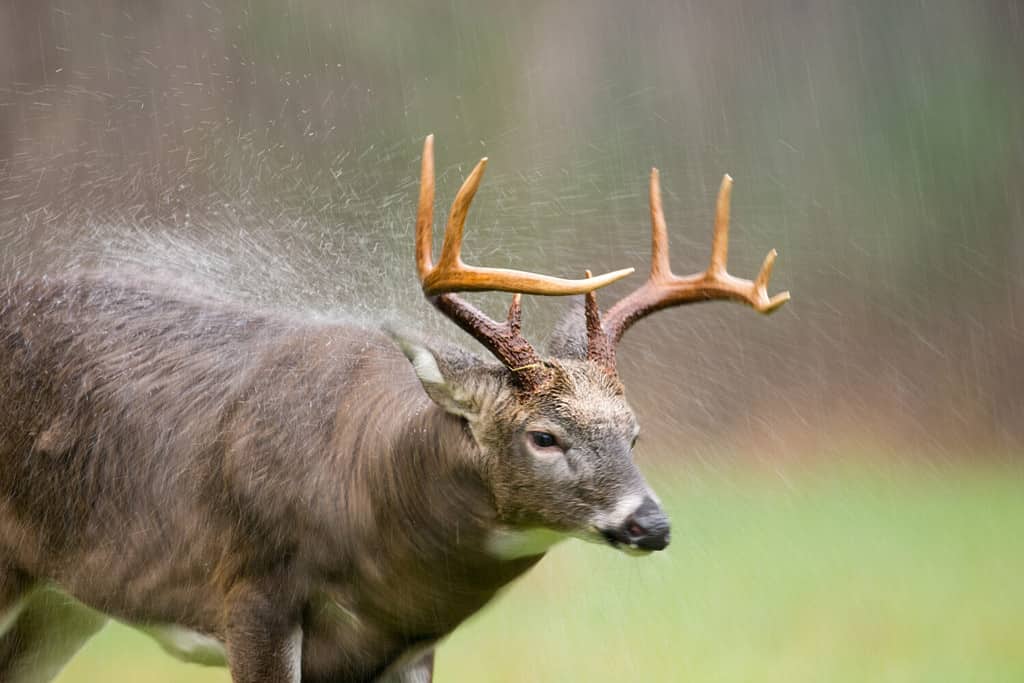
Approximately 800,000 to a million white-tailed deer live in Virginia.
©Tony Campbell/Shutterstock.com
Virginia’s diverse geography, ranging from coastal plains to mountainous regions, provides a habitat for various wildlife species. The state’s rich biodiversity supports numerous mammals, birds, reptiles, amphibians, and fish.
Mammals
- Black Bear: Virginia is home to a healthy population of black bears, particularly in the western part of the state. Shenandoah National Park and the Blue Ridge Mountains are prime bear habitats.
- Bottlenose Dolphin: You can spot bottlenose dolphins along Virginia’s coastline, particularly in the Chesapeake Bay and the Atlantic Ocean. Whale-watching tours are prevalent in this region.
- Eastern Coyote: Coyotes have become increasingly common in Virginia in recent years. They are adaptable predators and live in both rural and suburban environments.
- Red Fox: Red foxes are common in Virginia. They have an extensive adaptability to various habitats, from urban areas to rural landscapes.
- White-Tailed Deer: This species lives abundantly in Virginia. They are a favorite among wildlife enthusiasts and are a key species for hunters during the deer hunting season.
Birds
- Bald Eagle: Virginia has made significant strides in bald eagle conservation. These majestic birds of prey can be spotted along the state’s rivers, lakes, and coastal areas.
- Northern Cardinal: This bird, with stunning orange-red feathers, is Virginia’s state bird.
- Eastern Bluebird: This striking bird is a common sight in fields and open areas, often perched on fences and utility lines.
- Wild Turkey: Virginia’s woodlands and fields are inhabited by wild turkeys.
Fish and Aquatic Species
- Brook Trout: Virginia’s mountain streams and rivers are ideal habitats for brook trout, a native and prized sportfish.
- Chesapeake Bay Blue Crab: The Chesapeake Bay is famous for its blue crab population. These crabs are a staple in Virginia’s seafood industry.
- Striped Bass (Rockfish): Virginia’s rivers and coastal waters are home to striped bass, also called rockfish. They are popular among anglers and a critical species for the state’s fishing industry.
Reptiles
- Eastern Box Turtle: This land turtle is the state reptile of Virginia. The eastern box turtle, with its colorful markings and unique hinged shell, lives in forests, fields, and gardens across the state. It’s known for its distinctive box-like shell.
- Eastern Timber Rattlesnake: Virginia also has various snake species, including the Eastern timber rattlesnake. These venomous snakes are found in the state’s wooded areas.
Conservation efforts and protected areas in Virginia, such as national parks, wildlife refuges, and state forests, play a vital role in preserving the state’s diverse wildlife populations. Whether you’re an avid birdwatcher, angler, or wildlife enthusiast, Virginia offers numerous opportunities to observe and appreciate its unique flora and fauna.
The photo featured at the top of this post is © Kevin Ruck/Shutterstock.com
Thank you for reading! Have some feedback for us? Contact the AZ Animals editorial team.







